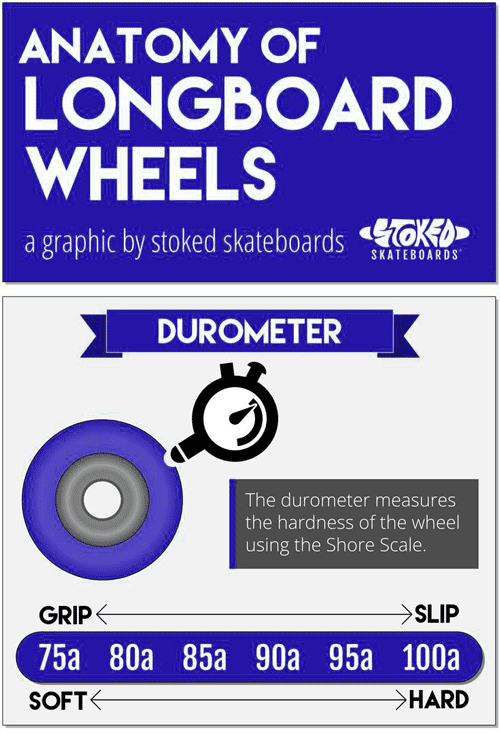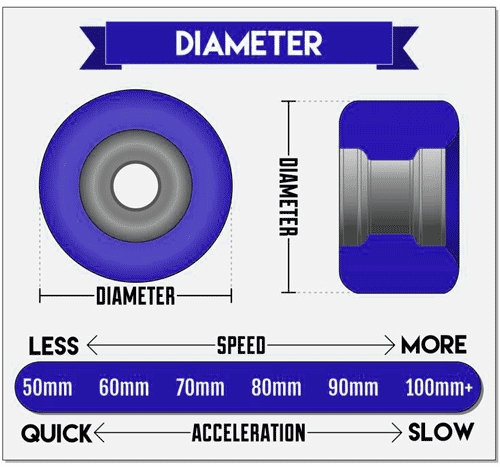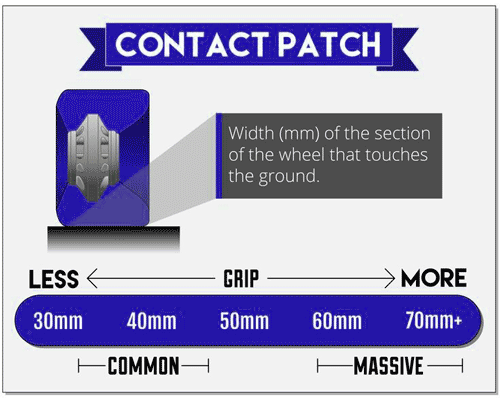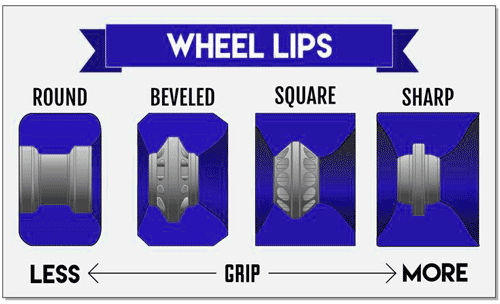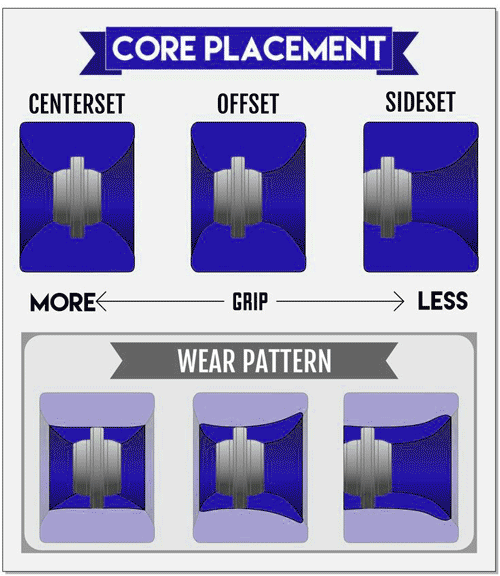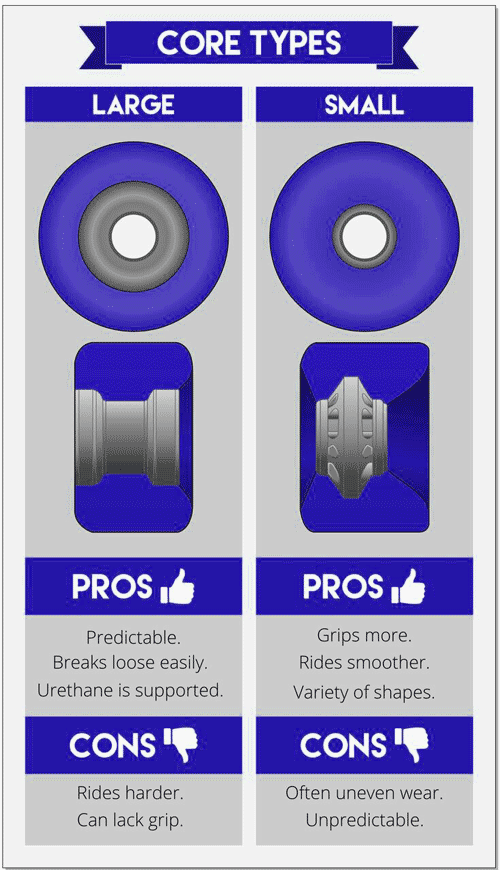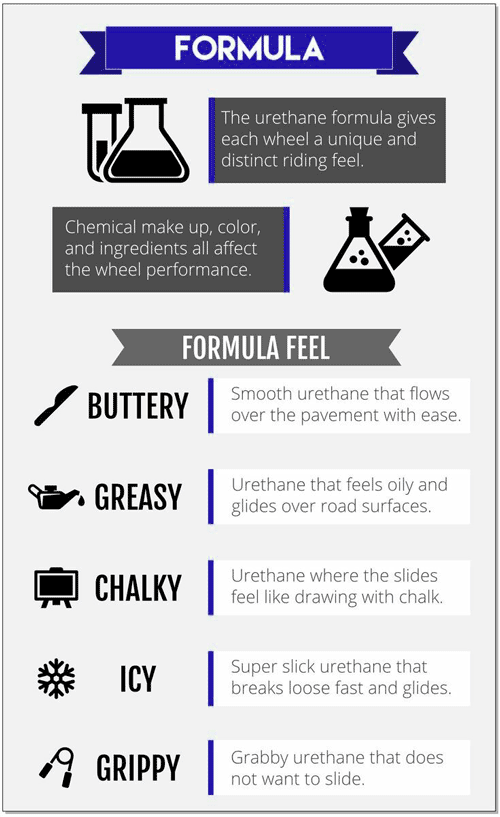ABOUT LONGBOARD WHEELS:
Special Thanks to the Folks at Stoked Ride Shop for the great article on Anatomy of Longboard Wheels.
Longboard wheels are not a “one size fits all” kind of thing. They come in different shapes, and varying densities, each with its own pros and cons. Whether you need a wheel to grip those hairpin turns or you would rather slide through that turn, either way this article will help you figure out what wheel you need to start ripping ASAP.
To get an idea of the wide variety of longboard wheels that are available you can check them out here: Over 400 Longboard Wheels
First up is the durometer of a wheel. Simply put, the durometer of a wheel tells you how hard or soft it is. The softer the wheel, or the lower the durometer, the more grip a wheel will give you. Opposite to that, the harder a wheel is the more likely it is to slide. Although, these are not hard and fast rules as a lot of the wheel’s grip or slip comes from other factors than just the hardness of wheel.
That being said, the hardness of the wheel will definitely impact your riding experience. Wheels that are close to 100a durometer will provide a harder platform to pop off of, but are uncomfortable when it comes to riding. For cruising we always recommend going with a softer wheel, as it absorbs more of the road in comparison to harder wheels.
Next up is diameter. Now, if you skipped math class you may be thinking, hmm I have no idea what that is. No worries! Diameter is just a fancy word for the size of a circle from one side to another. When choosing your wheel it is important to know how big it is, not only so you can make sure to have bigger wheels than your friends, but also so you can determine if it will fit on your board. One standard rule of thumb is big wheels go faster and small wheels accelerate better.
For example, a 97mm wheel would not work well on a standard downhill board. Guaranteed wheel bite! Oh right, wheel bite is when your wheel touches your board and stops moving, thusly removing you from the board and catapulting you forward. So needless to say, you don’t want wheel bite. If you want to rock a massive wheel make sure to get a board with cut outs so that you can turn all day without any worries.
CONTACT PATCH
Our third topic of discussion is the contact patch of a wheel. The diameter tells you how tall a wheel is while the contact patch tells you how wide it is. Or literally how much of the wheel will be in “contact” with the road. The more of the wheel that is touching the ground the more grip the wheel will have overall.
This because the amount of friction generated is much greater than if only a small portion of the wheel was in contact with the ground. When it comes to sliding, friction is your enemy; but when it comes to cruising friction is your lord and savior. You need to know what kind of riding that you will be doing and equip your board accordingly. The Biggie Hawgs are a great example of a wheel with a large contact patch.
Now, you may have the right durometer, diameter and contact patch but without the right lip shape the wheel still may not perform as well as you want it to. The rounder a wheel is the more it will slide and the more rigid and square the lip is the more the wheel will grip. Here are some examples of each kind: round lip, beveled lip, square lip, sharp lip. You can see that square and sharp are very similar and it’s because of this that they both deliver the same kind of ride and performance.
CORE TYPES
In the middle of the urethane of a wheel sits its plastic core. The core of a wheel provides stability for the urethane, otherwise it would be super squishy and extremely hard to ride. The size of the core will also have an effect on the performance of the wheel itself.
Larger cores provide a more predictable and consistent ride, while providing the urethane was ample support to keep your wheel shape as circular as possible at all times. The downside to a large core is that the riding isn’t as smooth and the wheel can sometimes lack grip.
Small cores, on the other hand, provide a lot of grip and keep the ride nice and smooth. They also allow the wheel to be shaped in a variety of ways. However, the wheels wear away at an uneven pace and are not as predictable or consistent as a large core wheel.
Now you might be thinking, okay so what core should I choose than? It may seem like a hard choice at first considering they both have pros and cons, but in the end it comes down to the style of riding you want to be doing.
For cruising, you always want the smoothest ride possible and the predictably of a wheel isn’t that important to you. Adversely, wheels with a large core are better for more experienced riders who demand consistency from their wheel. Whether it is for sliding or racing, the larger core will deliver a ride that is easier to anticipate.
CORE PLACEMENT
Now that we have gone over the size of the core we need to discuss the placement of the core within the wheel. Here are some examples of the three different common placements: Centerset, Offset, and Sideset.
Much like the size of the core, where the core is placed in a wheel will have it’s advantages and disadvantages, and will ultimately depend on the style of riding that you are doing.
Centerset wheels provide the most amount of grip and wear the most evenly, but they can’t slide well at all!
For sliding you would have a better time with a Sideset wheel. This is because when the slide is initiated the weight of the rider is transferred to the inside of the wheel, lifting the edge of the wheel, reducing the contact patch which in turn reduces the friction, all resulting in an easier and smoother slide.
WHEEL FORMULA
The last thing to consider when buying longboard wheels is the urethane formula that was used to create them. The components of a wheel: the colour, ingredients, and chemical make up, give each formula its own specific feel and experience. If you are cruising this stuff isn’t as important to you, as the formula stipulations typically tell you about the slidability of a wheel.
Most of the time, companies won’t tell you what their formula feels like, at least not without asking first. On the other hand, some companies like to name their wheels in such a way that there is no confusion.
Take the Cloud Ride Iceeez, for example. They are named Iceeez because they have an extremely “icy” formula. This means that they are extremely slippery and have very little control while sliding, like sliding on ice.
Another example of a company taking the naming of a wheel literally is the Sector 9 Butterballs. Named after their extremely buttery formula that keep the wheels sliding nice and evening across the pavement, like butter on a gritty piece of toast.
The urethane formula gives each wheel a unique and distinct riding feel.Chemical make up, color and ingredients all affect the wheel performance.
THANKS TO STOKED SKATEBOARDS INFO GRAPHIC. NEXT HOW TO CHOOSE YOUR LONGBOARD TRUCK GUIDE

